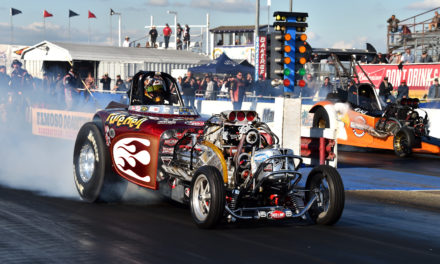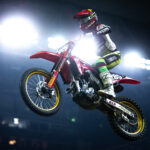Believe the marketing spin and you’d need nothing less than the latest SUV and a brazen attitude toward optional extras to traverse that awkward curb outside the school gates. Or for tackling a speed bump in town. But in the 1984 Paris-Dakar Rally, Porsche competed in one of rallying’s toughest challenges in a sports car—and won.
The Dakar hasn’t been held on the African continent since 2007, but prior to its move to South America (and more recently, Saudi Arabia), the route picked a hot, tortuous, and occasionally dangerous path through the Ivory Coast, Guinea, Sierra Leone, and Mauritania, finally finishing at Dakar in Senegal.
Those that made the distance in that 1984 event covered more than 12,000 kilometers (7450 miles)—and 5882 km (3650 miles) on special stages—over 20 days.

Photo: Thierry Rannou/Gamma-Rapho/Getty Images
More frequently contested in more conventional 4×4 vehicles, Porsche elected to field a trio of 953s: four-wheel drive variants of the G-series 911 Carrera 3.2, specifically adapted for the rigors of off-road racing.
Cutting an alien figure among the Mercedes and Mitsubishis, the 953 was designed to be strong and light, its caged shell draped in polycarbonate panels, from the roof, doors and bumpers, to every window except the front screen. At 1247 kg (2750 pounds) it was modest for an off-road racer, albeit around 100 kg (220 pounds) more than a standard 911 SC road car.

Photo: Thierry Rannou/Gamma-Rapho/Getty Images
If the shell wasn’t quite showroom-ready, the 3.2-liter flat six wasn’t far removed from more familiar Porkers. It was adapted for a lower compression ratio to avoid issues on the lower-grade fuel found in Africa at the time, but Porsche still quoted a healthy 300-hp output.
The big change though was its four-wheel drive system, sending 69 percent of its power to the rear axle, the rest to the front, with a manually locking center diff. The suspension too was quite unlike the road cars, front struts replaced up front by double-wishbones, and a reinforced rear axle, with maximum wheel travel of 270 mm (nearly a foot) to account for the demands of the route.

Photo: Porsche
Long, lonely miles at the wheel—the longest day in 1984 totaled 848km (527 miles), and the longest special stage a punishing 674 km (402 miles)—also required plenty of fuel capacity, so Porsche fitted twin tanks: 120 liters (31.7 gallons) up front, and 150 liters (39.6 gallons) aft of the driver.
Porsche also had a secret weapon in the form of driver Jacky Ickx, who had taken victory at the Dakar the year before in a slightly more traditional rally raid vehicle, a Mercedes 280 GE, and who Porsche credits, along with project leader Roland Kussmaul, as one of the guiding forces behind the project.
For Ickx though, a victory was not to be. On just the second day of the rally he first suffered a pair of punctures, sending him tumbling down the leaderboard if not down the road, and while recovering, his car then developed an electrical problem on the third stage, which resulted in a fire and further time lost.
Ickx and co-driver Claude Brasseur then embarked on a spectacular climb up from 139th place, setting multiple fastest stage times and a pace the press called “unbeatable”, but after another off on the eighth stage, losing three hours, the Belgian’s run for overall victory well and truly came to a halt. Despite this, Ickx and Brasseur still finished sixth overall, while teammate Kussmaul and his co-driver Erich Lerner managed 26th.
Against the best efforts of a giant-killing performance Citroën Visa on the 17th stage—somehow beating both front-running Porsches!—the top crew of René Metge and Dominique Lemoyne really were unstoppable. Chased hard by crews in a Range Rover and Mitsubishi Pajero, car 176 took a spectacular victory, making it the first sports car ever to do so in the Dakar.

(Photo by Philippe Le Tellier / Getty Images)
Not one to rest on its laurels, Porsche repeated this feat again in 1986, this time with the mighty 959 supercar. The 959 would use the 953’s all-wheel drive system, and after an exploratory year in 1985 (using the 959 shell, but the 953’s engine), the team returned, still Rothmans-branded in 1986 in full twin-turbocharged specification.

Photo: Thierry Rannou/Gamma-Rapho/Getty Images
The 1986 rally was heavily overshadowed by the death of organiser Thierry Sabine, along with singer Daniel Balavoine, reporter Nathalie Odent, journalist Jean-Paul Le Fur, and pilot Francoix-Xavier Bagnoud, in a helicopter crash during a sandstorm. But Porsche took its second victory, despite significant challenges from abnormally muddy conditions, and this time took second place too—the order again Metge followed by Ickx.
While a remarkable car in its own right though, 1986’s victory in the 959 may not have happened without the Porsche 953 furrowing that path before it. We’re unlikely to see the new 911 Dakar repeat such a feat, but it too would not exist—nor be anything like as desirable—without Porsche’s historic victory in 1984.

Photo: Porsche










